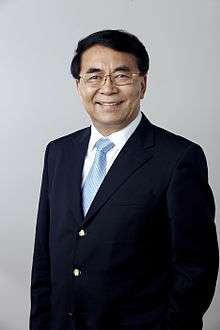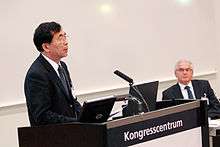Bai Chunli
Bai Chunli (Chinese: 白春礼; born September 26, 1953) is a Chinese physical chemist, nanoscientist, and politician. He is President of the Chinese Academy of Sciences (CAS) and Professor of the CAS Institute of Chemistry. He also serves as President of The World Academy of Sciences (TWAS), co-chairman of the China Association for Science and Technology, and President of the University of the Chinese Academy of Sciences.[5]
Bai Chunli 白春礼 | |
|---|---|
 Bai Chunli in 2014, portrait via the Royal Society | |
| Born | September 26, 1953[1] |
| Nationality | Chinese |
| Alma mater | Peking University |
| Awards |
|
| Scientific career | |
| Fields | |
| Institutions | |
Education and early life
Bai's father was a primary school teacher who encouraged Bai to read. In 1966, he went to middle school, graduating with a High School Certificate in 1970, at the time of the Cultural Revolution. After high school he joined the Down to the Countryside Movement with other young people. Bai Chunli worked in the Inner Mongolia production and construction corps for four years. In 1974, after the whole soldiers' secret ballot and the exam, Bai Chunli was recommended to be a student at Peking University graduating in 1978. In 1981 he received a master's degree of the Chinese Academy of Sciences, and in 1985 earned a doctor’s degree.
Career
In January 1978, after graduating from the university, Bai Chunli was assigned to the Chinese Academy of Sciences' applied chemistry department, which was the beginning of his research career in the Chinese Academy of Sciences. From 1985 to 1987, he did postdoctoral research in the Jet Propulsion Laboratory at the California Institute of Technology. In 1996, he was the Vice President of the Chinese Academy of Sciences; in 2011, he took over from Lu Yongxiang as sixth President of Chinese Academy of Sciences.
As of 2014 Bai is currently a part-time professor at Peking University, Tsinghua University, University of Science and Technology of China, Nankai University, and the China University of Geosciences, and a visiting professor at Liaoning Normal University and Nanjing Audit University.
Research
Bai's research is mainly in the field of nanotechnology[6][7][8] and scanning tunneling microscopy,[9][10][11] where his work focuses on scanning probe microscopy techniques, and molecular nano-structure, as well as nanotechnology research.[12] He has published a large number of books in both Chinese and English. He was an alternate committee member of the 15th and the 16th CPC Central Committee, and the sixth Vice President of the China Association for Science and Technology.
Bai conducted research in areas such as polymer catalyst structure and property, organic compounds of crystal structure X-ray diffraction, molecular mechanics and conductive polymers of EXAFS, etc. He has been engaged in the study of scanning tunneling microscopy, which has been a significant field in nanotechnology (NT), since the mid-1980s. Many of his works, both in Chinese and English, have been published by Germany Springer Publish Company and Scientific Company and many other publishing houses. Furthermore, he has earned many other awards such as Internationalism which is awarded by the International Chemical Industry association.
Bai Chunli is one of the pioneers in the field of scanning probe microscopy. The laboratory he leads organized much wide-ranging and detailed research. Bai has made many contributions to STM study nationally and internationally. He has created a team which aims to increase cooperation between China and the United States on the issue of regularly using energy sources. Bai has also devoted himself to shortening the scientific distance between China and foreign countries.
He is the editor of China Basic Science magazine, and plays an important role in the political field. In his youth, he was named the best worker around China and one of China's Top Ten Outstanding Young Persons among other distinctions.
His research has been published widely in peer reviewed journals and books.[13]
Awards and honours

- Academician of The World Academy of Sciences
- Academician of the Chinese Academy of Sciences
- Foreign associate of the US National Academy of Sciences
- Honorary Fellow of the British Royal Society of Chemistry
- Foreign academician of the Russian Academy of Sciences[14]
- Honorary Fellow of the Indian Academy of Sciences
- Corresponding fellow of the Australian Academy of Science (2013)
- Honorary member of Chinese Association for Science and Technology (2011)
- Foreign Member of the Royal Society (ForMemRS) in 2014.
- Honorary Fellow of the Royal Society of Edinburgh in 2015
His nomination for the Royal Society reads:
Dr. Chunli Bai is one of the pioneers in the field of nanoscience. In the mid-1980s, he successfully designed and developed China’s first atomic force microscope (AFM), scanning tunneling microscope (STM), low-temperature STM, ultrahigh vacuum-STM, and ballistic electron emission microscope. These led to the earliest technological tools in the country for manipulating single atoms and molecules, and characterizing surfaces and interfaces. He successfully established a methodology for the study of molecular assembly on solid substrate surfaces, such as the imaging of functional molecules on graphite surfaces. His use of alkane-assisted adsorption and assembly in this context is particularly noteworthy. Beyond his outstanding scientific achievements, Dr. Bai’s leadership role in Chinese science includes service as the President of the Chinese Chemical Society (1998-2010), and Vice-President (1996-2004), Executive Vice-President (2004-2011) and President (2011-present) of the Chinese Academy of Sciences (CAS). In 2012 he became the first Chinese President of the Academy of Sciences for the Developing World (TWAS).[15]
References
- Anon (2013). "Special Issue cover picture: Celebrating Professor Chunli Bai's 60th Birthday". Chemistry: An Asian Journal. 8 (10): 2285. doi:10.1002/asia.201390034.
- Scanning Tunneling Microscopy and Its Application, Springer, ISBN 9783540657156
- Bai, C (2005). "Global voices of science. Ascent of nanoscience in China". Science. 309 (5731): 61–3. doi:10.1126/science.1115172. PMID 15994515.
- Lin, Z. (1998). "The observation of the local ordering characteristics of spermidine-condensed DNA: Atomic force microscopy and polarizing microscopy studies". Nucleic Acids Research. 26 (13): 3228–3234. doi:10.1093/nar/26.13.3228. PMC 147677. PMID 9628923.
- Qiu, J. (2011). "Chinese Academy of Sciences has big plans for nation's research". Nature. doi:10.1038/news.2011.180.
- Tian, F.; Xiao, X.; Loy, M. M. T.; Wang, C.; Bai, C. (1999). "Humidity and Temperature Effect on Frictional Properties of Mica and Alkylsilane Monolayer Self-Assembled on Mica". Langmuir. 15: 244. doi:10.1021/la981008d.
- Qiu, X.; Wang, C.; Zeng, Q.; Xu, B.; Yin, S.; Wang, H.; Xu, S.; Bai, C. (2000). "Alkane-Assisted Adsorption and Assembly of Phthalocyanines and Porphyrins". Journal of the American Chemical Society. 122 (23): 5550. doi:10.1021/ja994271p.
- Li, B. S.; Cheuk, K. K. L.; Salhi, F.; Lam, J. W. Y.; Cha, J. A. K.; Xiao, X.; Bai, C.; Tang, B. Z. (2001). "Tuning the Chain Helicity and Organizational Morphology of anl-Valine-Containing Polyacetylene by pH Change". Nano Letters. 1 (6): 323. Bibcode:2001NanoL...1..323L. doi:10.1021/nl015540o.
- Li, B. S.; Cheuk, K. K. L.; Ling, L.; Chen, J.; Xiao, X.; Bai, C.; Tang, B. Z. (2003). "Synthesis and Hierarchical Structures of Amphiphilic Polyphenylacetylenes Carryingl-Valine Pendants". Macromolecules. 36 (1): 77. Bibcode:2003MaMol..36...77L. doi:10.1021/ma0213091.
- Jiang, Y.; Zhu, C.; Ling, L.; Wan, L.; Fang, X.; Bai, C. (2003). "Specific Aptamer−Protein Interaction Studied by Atomic Force Microscopy". Analytical Chemistry. 75 (9): 2112–6. doi:10.1021/ac026182s. PMID 12720349.
- Li, J.; Bai, C.; Wang, C.; Zhu, C.; Lin, Z.; Li, Q.; Cao, E. (1998). "A convenient method of aligning large DNA molecules on bare mica surfaces for atomic force microscopy". Nucleic Acids Research. 26 (20): 4785–4786. doi:10.1093/nar/26.20.4785. PMC 147909. PMID 9753751.
- "Bai Chunli-Chinese Academy Of Sciences". English.cas.cn. 2011-03-07. Archived from the original on 2013-07-04. Retrieved 2012-06-05.
- "白春礼院士著作". Spm.com.cn. Archived from the original on 2013-11-22. Retrieved 2012-06-05.
- Бай Чунли Russian Academy of Sciences (in Russian)
- "Professor Chunli Bai ForMemRS". London: The Royal Society. Archived from the original on 2014-12-22.